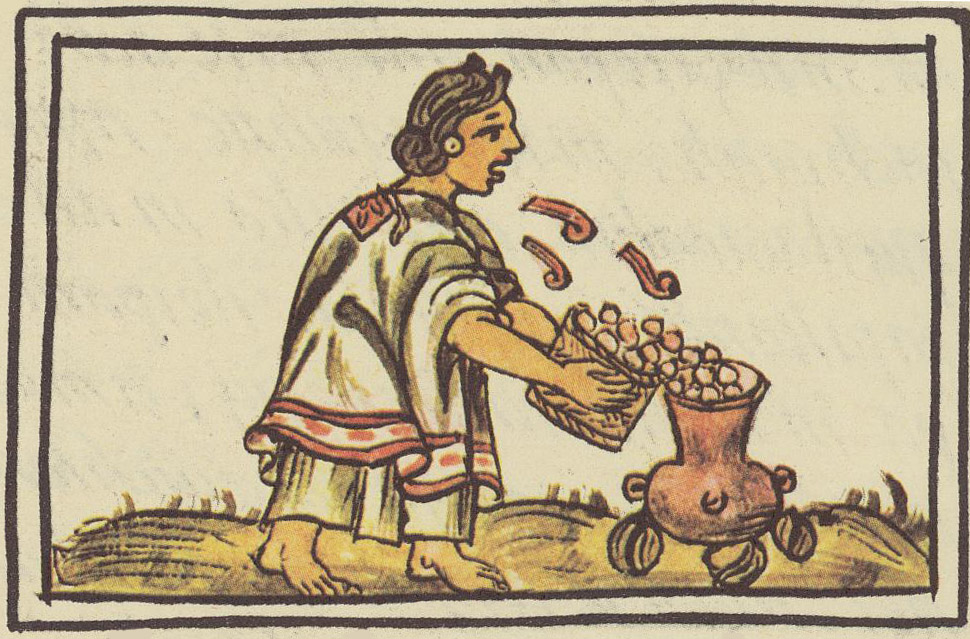Aztec Sacrifices
A pattern in all the blog entries I
have written and that I hope you have noticed is the use of sacrifice,
typically human. I have written 3 entries and in all of them, each god had his
or her own reason for human sacrifice. Many cultures practiced human sacrifice
however the Aztecs took it to a whole new level.
Why Sacrifice?
The reason human sacrifice was such
a huge deal in a lot of Mesoamerican cultures is because it was their way of
thanking the gods for their own sacrifices that they had made to make the
earth, sun, moon and stars. They believed that Huitzilopochtli and Tezcatlipoca
were torn apart and went through great trials to create the world. Another
reason for the acts of sacrifice was to appease the gods and apologize for the
way humans came into the world. The tale of Ehecatl-Quetzalcóatl, the god who
stole bones from the underworld to create the first humans and because humans
were created through such evil ways, they must show their gratitude to the gods
for allowing them to survive.
History of Human Sacrifice
Human sacrifice
can be traced back to many different societies and people groups. Many believe that
the Israelites, Hawaiians, Egyptians, Chinese and Celts all practiced some sort
of human sacrifice. Human sacrifice can be traced back to 5,500 years ago in
Sudan, Africa.
Different
cultures are also known for having their own special brands of sacrifice. In Israel
for example are most known for the sacrifice of children by burning them alive,
while the Ancient Hawaiians would often bash in the skull with a club.
Why Aztec Sacrifice was Unique
The reason
the Aztecs are so different from all these other cultures and why they are
viewed as so much more vicious then these other cultures that practiced human
sacrifice is because of the scale that these sacrifices were commited. The Aztecs
commited the most sacrifice of any culture that practiced human sacrifice. It
is believed that an average of around 20,000 people were sacrificed a year. An example
of a very large sacrifice was when the temple for Huitzilopchtli was built in
1487 when an estimated 80,400 were sacrificed.
Types of Sacrifices
The
Aztecs had many types of sacrifices from non-fatal sacrifices to painful deaths
and ripping out still beating hearts. Certain gods had specific wants and
needs. Some gods were appeased by the burning of incense or festival and song,
some gods accepted animals such as deer, butterflies and birds while others
needed humans to die in sacrifice. Huitzilopochtli for example was only satisfied
when being offered the gift of a still beating human heart.
Because
all gods had different needs that meant that nobody was safe from sacrifice,
man, women, children and babies have all played their part in appeasing the
gods.
Modern Day Human Sacrifice
Today
human sacrifice is no longer practiced and is definitely no longer accepted
amongst almost all cultures, although some parts of the world are indifferent
like in certain parts of Papua New Guinea, but if there are acts of human
sacrifice in some smaller village regions in Papua New Guinea it is typically cannibalism.
There
have been many cases of human sacrifice over the years, especially involving
cults and developing countries. In Africa it is believed that hundreds of kids
that go missing are sacrificed by witch doctors in order to improve business.
There are also cases of cults committing human sacrifices such as in 2006 when
in Barha, India it was discovered that an unnamed group had sacrificed around a
dozen children over the period of 6 months or in California when Steven Hurd, who
lead a small group of devil worshipers, who was convicted of killing 2 people,
one man and one women in what is believed to be one of the most notorious cases
in Orange County.
Bibliography
Aztec Sacrifices." About.com Education. Web. 29
Oct. 2015.
Aztec Sacrifice." Ancient History Encyclopedia.
Web. 29 Oct. 2015
BBC News. BBC. Web. 30 Oct. 2015
Burnt Offering of Children - Canaan and Israel." Burnt
Offering of Children - Canaan and Israel. Web. 30 Oct. 2015.
How Many People Did the Aztecs Sacrifice?" History
Extra. Web. 30 Oct. 2015.
O.C. Devil-worshipping Killer Died Quietly." The
Orange County Register. Web. 30 Oct. 2015.
The Oldest Human Sacrifice: 5,500 Years Old!" Softpedia.
Web. 30 Oct. 2015
Where Human Sacrifices Are Still Taking Place throughout the
World." Mirror. 3 July 2015. Web. 30 Oct. 2015




